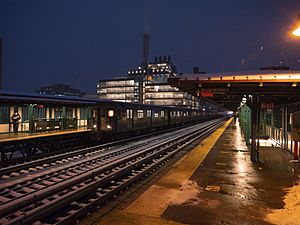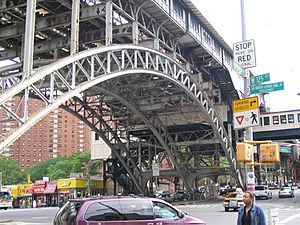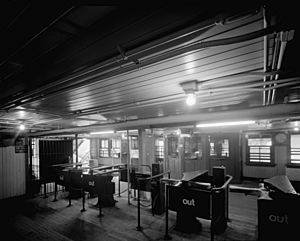125th Street station (IRT Broadway–Seventh Avenue Line) facts for kids
Quick facts for kids
125 Street
|
|||||||
|---|---|---|---|---|---|---|---|

Southbound 1 train arrives in the evening
|
|||||||
| Station statistics | |||||||
| Address | West 125th Street & Broadway New York, NY 10027 |
||||||
| Borough | Manhattan | ||||||
| Locale | Manhattanville, Morningside Heights | ||||||
| Coordinates | 40°48′54″N 73°57′29″W / 40.815°N 73.958°W | ||||||
| Division | A (IRT) | ||||||
| Line | IRT Broadway–Seventh Avenue Line | ||||||
| Services | 1 alltimes (all times) | ||||||
| Transit connections | |||||||
| Structure | Elevated | ||||||
| Platforms | 2 side platforms | ||||||
| Tracks | 3 (2 in regular service) | ||||||
| Other information | |||||||
| Opened | October 27, 1904 | ||||||
| Station code | 306 | ||||||
| Opposite-direction transfer available | Yes | ||||||
| Former/other names | Manhattan Street | ||||||
| Station succession | |||||||
| Next north | 137th Street–City College: 1 alltimes | ||||||
| Next south | 116th Street–Columbia University: 1 alltimes | ||||||
|
|||||||
|
|||||||
|
|||||||
|
|
|||||||
|
IRT Broadway Line Viaduct (a.k.a.; Manhattan Valley Viaduct)
|
|||||||
| NRHP reference No. | 83001749 | ||||||
| Significant dates | |||||||
| Added to NRHP | September 15, 1983 | ||||||
The 125th Street subway station, once called Manhattan Street, is a local station in the New York City Subway system. It's on the IRT Broadway–Seventh Avenue Line. You can find it where 125th Street meets Broadway in Manhattan. This station sits between the Manhattanville and Morningside Heights areas. The 1 train stops here all the time.
This station was built for the Interborough Rapid Transit Company (IRT). It was part of New York City's very first subway line. Building started on June 18, 1900. The station opened on October 27, 1904. It was one of the first 28 subway stations in the city. The platforms were made longer in 1948. The station also got a big update in the 2000s.
The 125th Street station has two side platforms. It also has three tracks, but the middle track isn't used for regular trains. This station is special because it's the only one on the long Manhattan Valley Viaduct. This viaduct is like a bridge that carries the subway line over a natural valley. The platforms have walls to block wind and roofs for shelter. Below the platforms, there's a station house with exits to 125th Street and Broadway. The Manhattan Valley Viaduct is a New York City landmark. It's also listed on the National Register of Historic Places.
Contents
Station History
Building the Subway Line
Plans for New York City's first subway line began in 1894. Engineers, led by William Barclay Parsons, designed the subway. The plan was to build a subway from New York City Hall to the Upper West Side. From there, two branches would go north into the Bronx. This plan was officially approved in 1897.
A company called Rapid Transit Construction Company signed a contract in 1900. They agreed to build the subway and run it for 50 years. August Belmont Jr. helped fund this project. In 1902, he started the Interborough Rapid Transit Company (IRT) to operate the subway.
How the 125th Street Station Was Built
The 125th Street station was part of the IRT's West Side Line. Most of the original subway was built underground. But in the Manhattanville area, the land was uneven. So, they had to build a large viaduct, or elevated structure. This viaduct stretches from 122nd to 135th Streets.
Work on this viaduct began on June 1, 1901. It was built very quickly, in about two weeks. The section around 125th Street was first planned with two tracks. But in 1901, they changed it to three tracks. This allowed trains to be stored on the center track.
The 125th Street station opened on October 27, 1904. It was originally called the Manhattan Street station. It was one of the first 28 stations on the New York City Subway.
Changes and Updates Over Time
Early 20th Century Changes
After the subway system was finished in 1908, the station served both local and express trains. To help with crowded trains, platforms were made longer. In 1910, a plan was made to extend platforms for longer trains. The northbound platform at 125th Street was extended about 98 feet.
In 1915, some stairways were moved, and new ones were added. Passageways were also made wider. The station's name officially changed to 125th Street in 1921. This happened after a request from the Harlem Board of Commerce. A new waiting area opened in 1931. It included three new escalators and a new staircase to the street.
Mid-20th Century Updates
Between 1946 and 1948, platforms were made even longer. This allowed full ten-car express trains to stop at the station. Before this, longer trains couldn't open all their doors. The platform extensions at 125th Street opened on June 11, 1948.
Around this time, subway lines got number names. The Broadway/West Side route became known as the 1 train. By 1959, all 1 trains became local trains.
In 1981, the Manhattan Valley Viaduct, including the 125th Street station, became a city landmark. It was added to the National Register of Historic Places in 1983.
In 1988, there were plans for "skip-stop" service. This meant some trains would skip certain stations to go faster. People didn't want 125th Street to be a skip-stop station. So, when skip-stop service started in 1989, 125th Street was still served by both the 1 and 9 trains.
21st Century Renovations
In 2002, the Metropolitan Transportation Authority (MTA) announced big renovations for ten subway stations. The 125th Street station was one of them. These updates included new flooring, better electrical systems, and new lighting. They also planned to restore historical parts of the station.
The local community was very involved. They wanted to make sure the station's historic look was kept during the renovation. Columbia University helped pay for some of the updates. They even funded replacing aluminum vents with glass windows to match the station's original design.
To speed up the work, the downtown platforms at 110th Street and 125th Street were closed for a few weeks in 2003. The skip-stop service ended completely on May 27, 2005.
Station Design
This station is part of the original subway system. It has two side platforms. There are three tracks, but the middle one is not used for regular train service. Both platforms have light brown walls to block wind. They also have red roofs to keep people dry.
The windscreens have windows with green frames. These were added during the 2003 renovation. At the ends of the platforms, where there are no roofs, you'll find green iron fences.
The Viaduct Structure
The 125th Street station is the only station on the long Manhattan Valley Viaduct. This viaduct is about 2,174 feet (663 meters) long. It crosses the Manhattanville area from 122nd to 135th Streets. The viaduct helps trains stay level and avoid steep hills as they go through the valley.
The steel arch over 125th Street is about 168.5 feet (51.4 meters) long and 54 feet (16 meters) high. It's made of strong steel ribs. Most of the rest of the viaduct is a simple steel structure. When it was finished, the viaduct was painted dark green.
Some experts have praised the viaduct's design. One critic said it was a great example of engineering. Other writers compared the arch to the famous Eiffel Tower.
Station Exits
The station has one elevated station house. It's located in the middle of the platforms and tracks. From each platform, two staircases lead down to a waiting area. Here, you'll find turnstiles to enter or exit the station.
On the west side of the station house, there's a ticket booth. An enclosed walkway leads to two escalators. These escalators go down to the west side of Broadway. One escalator goes north to 125th Street, and the other goes south to Tiemann Place.
On the east side, another enclosed walkway leads to an escalator. This escalator faces south and goes down to the southeast corner of Broadway and 125th Street. There's also an "L" shaped staircase nearby that leads to the same corner. When the station first opened, there were even escalators going down to the middle of Broadway.
- nycsubway.org – IRT West Side Line: 125th Street
- nycsubway.org – River to River Artwork by Wopo Holup (1991)
- Station Reporter – 1 Train
- Forgotten NY – Original 28 - NYC's First 28 Subway Stations
- The Subway Nut – 125th Street Pictures
See also
 In Spanish: Calle 125 (línea de la Séptima Avenida–Broadway) para niños
In Spanish: Calle 125 (línea de la Séptima Avenida–Broadway) para niños









